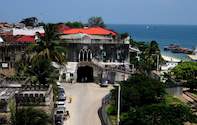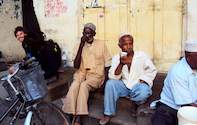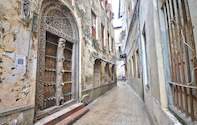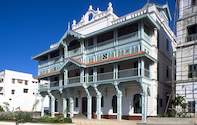
Behind the scenes - an architectural look at Stone Town
Walking around Zanzibar's famous Stone Town is an architecture buff's delight - the variety of building styles on view provides a whistle-stop tour of the island's long and varied history. Arab mansions with high, blank white walls sit next to the lacy wooden balconies and colourful stained glass windows of grand Indian residences.
If you look hard enough, you'll even be able to glance further back in history and find some remnants of the heyday of the Swahili civilisation, which ruled supreme in this part of Africa as long ago as the 10th century.
But as you stroll around, spare an eye for the smaller details as well as the overall historical picture. Some of Stone Town's most commonplace architectural features have fascinating stories to tell.
Baraza Benches

Barazas, or benches, have been a focal point of community life in Zanzibar for centuries. Benches run around verandahs outside traditional Swahili homes, or flank the heavy doors in more distinctively Arab-style townhouses. The long, narrow streets of Stone Town have baraza benches built on each side instead of pavements, while in the villages a palm-leaf shelter, flanked by wooden seats, fulfils the same function.
Baraza evolved as a way for Islamic men to receive visitors in their homes without compromising the privacy of their womenfolk. Coffee and sweetmeats would be served on the baraza to anyone who arrived, with only the closest friends or family members being invited into the innermost recesses of the house. The Omani sultans held public meetings, also known as baraza, outside their palaces to receive petitioners or give visiting dignitaries a public audience.

Today, baraza are still a meeting point for all sections of Zanzibari society. Every urban baraza is lined with people lolling on the warm, smooth cement benches, gossiping, playing games of bao or cards, drinking sweet, thick Arabic coffee or simply idling away a long afternoon with a nap.
Draughts boards are scratched in chalk on the stone surfaces, ladies sit comfortably to plait each others' hair, and for traders with no market stall of their own, baraza provide a flat surface on which to pile their tiny pyramids of oranges, tomatoes and mangos.
In the rainy season, when torrents of water, sometimes laced with rubbish, make waking down the streets of Stone Town uncomfortable and even hazardous, the baraza provide a useful elevated walkway, and pedestrians jump from one to the next in an attempt to keep their feet dry.
The baraza as an architectural feature is an idea that seems to have caught on in a big way among the designers of Zanzibar's posher hotels, and almost every courtyard, nook and cranny and even bathroom now boasts its own baraza bench, whitewashed to match the coral walls or inlaid with mosaic tiles.
Doors

No description of Stone Town could be complete without a mention of the famous Zanzibar doors. These massive teak or mahogany structures grace the front of almost every building of note, and their style has been copied all over the world.
The original Zanzibar doors owe their distinctive brass studs to India - the studs originated as a defence against war elephants, used to batter down fortified doors in the tribal wars of Punjabi history. Needless to say, this distinctive feature of Stone Town's doors has always been purely decorative.
Also now obsolete is the smaller opening set inside many of the more massive of Zanzibar's doors - this allowed visitors to come through only one at a time, stooping as they did so, and prevented the larger doors being forced open by a sudden attack by a hidden enemy.
To the casual glance one old Zanzibar door may look very much the same as another. Look a little closer, however, and each door is subtly different. The craftsmen who carved both the doors themselves and the stone reliefs above them tailored each door to the social position, religious practices and occupation of its future owner
Thus a merchant who'd made his fortune from a fleet of fishing boats would reside behind a door whose carved patterns flowed sinuously up and down like the waves on the beach, or perhaps overlapped like the scales on a great marlin or swordfish.
Due to the Islamic ban on depicting living things, most door patterns were abstract, their designs only suggesting the natural objects that inspired them. The outermost strip of the doorframe is always carved with a chain or rope in order to enslave any evil spirits attempting to force their way into the residence. The Arab inscriptions carved in the stone frieze above the lintel are usually verses from the Koran or the names of the house owner who commissioned the door.
If the doors take your fancy as you stroll around Stone Town, avoid the temptation to buy one of the brass studs or a piece of wooden carving on sale in the curio shops as a souvenir. Too many of Zanzibar's precious antique doors have already left the island, ripped out of their true context and taken away to decorate foreign houses. Reproduction doors, studs and pieces of carving are easily found, and keep up the tradition of Zanzibar's skilled door carvers without desecrating their original handiwork.
Balconies
Another notable feature of Stone Town's houses are their balconies. Intricately carved from rosewood or teak, these are an import from India and owe much to the havelis of Gujerat, homeland of many of Zanzibar's wealthy Indian merchants. The bigger the balcony, the greater the status of the owner.
Like the covered bridges built by the Swahilis, these enclosed balconies allowed the ladies of the house to take the air while still being shielded from prying eyes in the street below.
Today you're more likely to see a string of washing on a balcony than an exotic beauty, but keep looking up as you stroll around the streets - far above ground, neighbours lean on their balconies or out of their windows to exchange gossip across the narrow streets that separate them.

The finest balconies in Stone Town are those running around the so-called Old Dispensary (now renamed the Zanzibar Cultural Centre). The magnificently frilled façade of this fine old building was commissioned by a wealthy Indian named Tharia Thopan, who made his millions in the nineteenth century as a businessman and advisor to Sultan Barghash. The building was not his private residence, but a hospital he founded in his charitable later years. His own house was the imposing building now occupied by the Emerson & Green hotel.
The European occupants of Zanzibar left their mark on the city's face too. The enormous Anglican cathedral was built on the orders of the famous Bishop Steere, champion of the anti-slavery movement and head of the powerful Universities Mission to Central Africa.
As a final triumph of church over commerce, the church was consecrated on the site of the former slave market, with the altar taking the place of the whipping post at its centre. The wooden crucifix is made from the tree under which David Livingstone, the abolitionists' champion, died in Zambia.
Copyright © Gemma Pitcher 2004

 Beyt Al Salaam, formerly known as Beyt al Chai, is a lovely Zanzibar hotel in Stone Town filled with ancient history, lots of activities, an...
Beyt Al Salaam, formerly known as Beyt al Chai, is a lovely Zanzibar hotel in Stone Town filled with ancient history, lots of activities, an... Kholle House is a sumptuous historical Zanzibar boutique hotel in Stone Town that once belonged to the Sultans daughter Princess Kholle....
Kholle House is a sumptuous historical Zanzibar boutique hotel in Stone Town that once belonged to the Sultans daughter Princess Kholle....